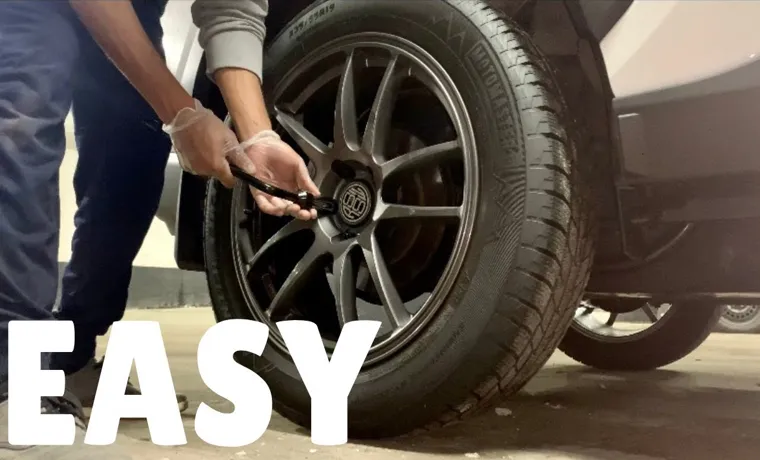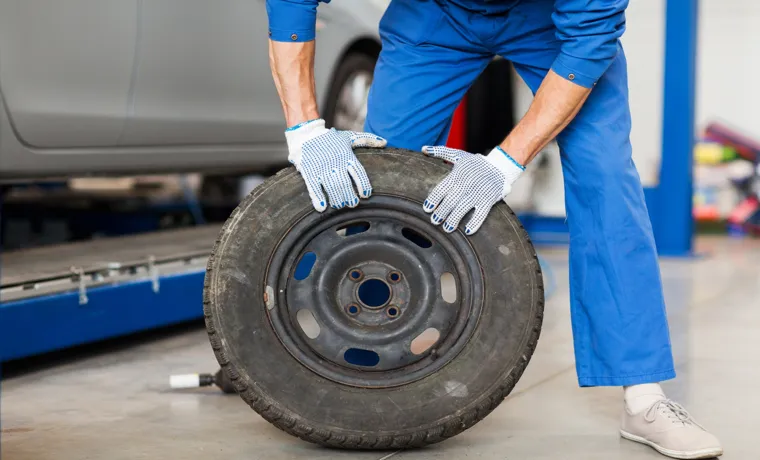As a driver, you may have heard of “tire changeover” before, but do you know what it means? Essentially, a tire changeover is a practice of changing your vehicle’s tires from either winter or summer tires to all-season tires or vice versa. This is an important process that ensures your car’s safety when driving under different weather conditions. In winter, you need winter tires that can grip the road better due to lower temperatures and snowy conditions.
Whereas in summer, all-season tires are better suited for hot temperatures, rainfall, and dry roads. In this blog post, we’ll explore the details of why tire changeovers are critical and how to prepare for them.
Table of Contents
Definition and Overview
“What is a tire changeover?” A tire changeover is the process of switching out one set of tires on a vehicle for another set, typically from summer or all-season tires to winter tires or vice versa. It involves removing the old tires and installing the new ones, ensuring they are properly balanced and aligned for optimal performance and safety. This is an important task to ensure your vehicle is equipped with the appropriate tires for the current weather and road conditions to maintain traction and handling.
It’s recommended to have a tire changeover performed twice a year, usually in the spring and fall, depending on where you live. It’s important to note that if you’re unsure about performing a tire changeover on your own, it’s best to seek assistance from a professional tire technician to ensure the job is done correctly.
Explanation of Tire Changeover
Tire Changeover If you live in an area with seasonal weather changes, then you’ve probably heard of tire changeover. This is the process of switching your vehicle’s tires from summer or all-season tires to winter tires, and vice versa. Winter tires are designed to provide better traction and control in snowy and icy conditions, while summer or all-season tires are designed for better performance in warm weather.
The changeover process involves swapping out the tires and rims, balancing and aligning them, and properly storing the unused set. It’s crucial to follow the manufacturer’s recommended tire type and size for your vehicle to ensure your safety on the road. Remember to schedule your tire changeover before the first snowfall to avoid any last-minute rush and stay prepared for any winter driving challenges that may come your way.

When is a Tire Changeover Required?
A tire changeover is something every car owner will need to consider at some point. A tire changeover is the process of switching out your car’s tires for a different set based on the weather conditions and driving needs of the moment. If you live in an area with harsh winters, you may need to switch to winter tires when the weather starts to get cold.
Conversely, you may need to swap to summer tires when the temperature starts to rise. Additionally, tire changeovers may be necessary if your current set of tires is worn out and needs replacement. The main keyword, tire changeover, is vital for understanding the process and making informed decisions about when and how to swap out your tires.
Keeping on top of tire maintenance can help you stay safe on the road and prolong the life of your vehicle.
Process of Tire Changeover
A tire changeover is a process of replacing the existing tires of a vehicle with new ones. The process is essential as tires wear out over time, which affects their ability to provide traction and control, leading to unsafe driving conditions. A tire changeover typically involves removing the old tires, inspecting the wheels, and installing new tires onto them.
Before the installation process, the wheels are cleaned, and any rust or corrosion is removed, ensuring a secure fit for the new tires. Once the tires are fixed onto the wheels, they are balanced, and the alignment is checked to guarantee even wear and proper handling. A tire changeover typically takes one to two hours, depending on the vehicle’s make and model and the number of tires that need to be changed.
It is essential to schedule tire changeovers timely to maintain safe driving conditions and prolong the life of your vehicle’s tires. So, if you notice any signs of wear and tear on your tires, it is best to get them checked by a professional mechanic to ensure optimum safety on the road.
Steps involved in Tire Changeover
Tire changeover can be a daunting task, but it’s an essential part of vehicle maintenance. There are several steps involved in the process of tire changeover. The first step is to park your vehicle on a level surface and engage the parking brake.
Next, loosen the lug nuts on the wheel that needs to be changed. Lift the vehicle using a jack and remove the lug nuts and the tire. Now, it’s time to install the new tire.
Place the tire on the hub and replace the lug nuts, tightening them in a star pattern to ensure even pressure. Lower the vehicle and use a torque wrench to tighten the lug nuts to the manufacturer’s recommended torque specifications. Finally, check the tire pressure to make sure it meets the recommended level.
Proper tire changeover ensures your vehicle’s safety and performance on the road. So, take the time to do it right!
Time and Cost of a Tire Changeover
Tire Changeover Changing your vehicle’s tires is something that requires attention and planning, especially if you want to save time and money. The process of tire changeover involves removing the current tires, prepping the rims, mounting and balancing the new tires, and finally reattaching them to the vehicle. The time it takes to complete a tire changeover depends on various factors such as the complexity of the process, the skill level of the technician, and the tools and equipment being used.
Generally, a professional tire changeover can take anywhere between 30 minutes to 2 hours. However, you can save time by booking an appointment in advance and choosing a time of the day that is not too busy. As for the cost, the price of a tire changeover depends on whether you are changing all four tires or just one or two.
It also varies among tire stores or garages, so it is essential to do some research beforehand to find the best deal. Ultimately, a tire changeover is a necessary and vital aspect of vehicle maintenance, and it is better to do it sooner rather than later to avoid potential accidents or damage to your car.
Tips for a Successful Tire Changeover
Tire Changeover When it comes to changing your tires, there are a few things you can do to ensure a successful process. First and foremost, ensure that you have all the necessary tools and equipment, including a jack, lug wrench, and spare tire. Once you have these items, you can begin the process of removing the old tire and installing the new one.
Start by loosening the lug nuts before jacking up the vehicle and removing the old tire. Then, simply align the new tire with the wheel studs and tighten the lug nuts before lowering the car and testing the tire pressure. It’s important to remember to check your tire pressure regularly to avoid any potential mishaps on the road.
By following these simple tips, you can have a successful tire changeover and ensure your vehicle is ready for the road ahead.
Importance of Tire Changeover
Getting a tire changeover is an important process that you should not neglect. It refers to the process of removing the existing tire from your car and replacing it with a new one to ensure optimal performance and safety of your vehicle. If you don’t change your tires on time, you’ll risk losing traction, which can lead to severe accidents, especially in rainy and snowy conditions.
The lifespan of your car tires is affected by several factors, including driving habits, road conditions, and weather changes. If your tires are showing excessive wear or have reached their maximum mileage, it’s time to take your vehicle to a professional and get a tire changeover. By doing so, you’ll not only ensure your safety but also increase the durability and efficiency of your car’s tires.
So, if you haven’t considered getting a tire changeover, it’s high time you do so to avoid putting your safety at risk.
Improves Vehicle Performance
Tire Changeover Tire changeover is an integral aspect of vehicle maintenance that often gets neglected. Many people mistakenly believe that as long as the car is running smoothly, there is no need to change the tires. However, this could not be further from the truth.
Regular tire changeovers improve vehicle performance, making it a crucial upkeep procedure. Tires undergo wear and tear over time, and this affects their ability to grip the road. Worn-out tires can pose a safety risk, and they also affect fuel economy and handling.
A changeover ensures that the tires are in good condition, providing optimal performance in all weather conditions. With new and properly functioning tires, the vehicle can handle sudden braking and sharp turns more efficiently, providing a safer driving experience. Additionally, new tires can contribute to better fuel economy, saving you money in the long run.
Therefore, regular tire changeovers are not optional, but a necessity for every car owner who wants to maintain their vehicle’s optimal performance.
Ensures Safety on the Road
Tire changeover is a crucial step in ensuring the safety of drivers on the road. It’s recommended to swap out your tires at least twice a year, once for winter and once for summer. This rotation helps to maintain proper tread depth and ensures that your tires are well-equipped to handle the weather conditions of each season, protecting both you and your vehicle.
Driving with worn-out tires can be incredibly dangerous, as it reduces your ability to stop quickly and can lead to skidding. It’s essential to have a professional perform your tire changeover as they can ensure that you have the right type of tire for your vehicle and the road conditions. Remember, your safety on the road begins with taking care of your tires.
Conclusion
In the world of automobiles, the tire changeover is a crucial rite of passage for every vehicle. Like a wardrobe change in the spring, this process involves swapping out the old, worn out tires for new, fresh ones that are ready to grip and roll. It’s a bit like giving your car a new pair of shoes- except these ones increase traction, provide better handling, and keep you safe on the road.
So, the next time someone asks you what a tire changeover is, you can tell them it’s like upgrading your ride’s footwear game- but with a lot more torque and a lot less fashion sense.”
FAQs
What is a tire changeover?
A tire changeover is the process of replacing your vehicle’s current tires with a new set of tires.
When should you consider a tire changeover?
You should consider a tire changeover when your current tires are worn out, have become bald, or have developed uneven wear patterns.
How long does a tire changeover take?
The time required for a tire changeover can vary depending on various factors like the number of tires being changed, the type of vehicle, and the availability of equipment. However, it usually takes about an hour or two.
Can I switch my winter and summer tires myself?
While switching your tires yourself is possible, it is not recommended unless you have the required tools and expertise. It’s always best to let a professional handle it to avoid any damage to your tires or vehicle.
What should I look for when buying new tires?
When buying new tires, you should consider factors such as the type of tire, the size of the tire, the tread pattern, the load and speed rating, and the brand’s reputation.
How often should I change my tires?
You should change your tires when they are worn out, have developed uneven wear patterns, or are more than six years old. It’s also recommended to change them before the winter season to ensure you have enough grip and traction on snowy roads.
What’s the difference between all-season tires and winter tires?
All-season tires are designed to provide reliable performance in both wet and dry conditions, whereas winter tires are specifically designed for cold and snowy conditions. Winter tires have a more aggressive tread pattern and are made with a rubber compound that stays pliable in cold temperatures.



